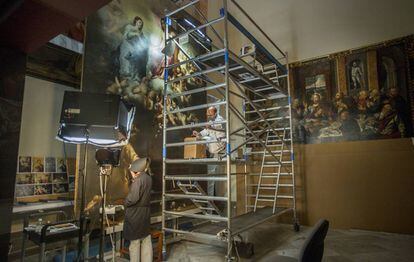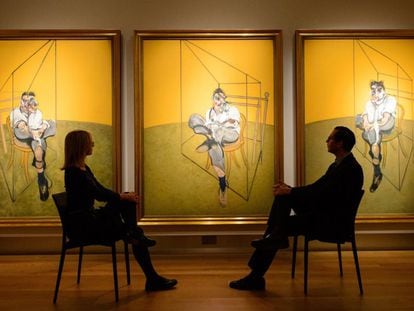Murillo: much more than just a pious painter
400th anniversary of the artist’s birth is observed by showcasing works that were taken out of Spain


Within the paintings of Bartolomé Esteban Murillo (1617-1682), one can find the essence of the Baroque metaphor: light and shade, artifice and simplicity, devotion and mundanity. Celebrations for the 400th anniversary of the Spanish painter’s birth kick off this week with a concert led by early music master Jordi Savall at the Maestranza theater, where the viola da gamba expert will recreate the sonic landscape of the city in which the painter was born. Seville has pulled out all the stops for the anniversary in order to reclaim an artist who has been trapped in clichés for a very long time.
The ultimate goal is to spread the arguments that researchers have been insisting on for years in specialized publications and at international symposiums: Murillo is not just the artist who evoked the religious world and who managed to give an amiable air to the spirit of the Counter-Reformation. He is also the painter who opted for profane scenes, paintings of everyday people doing everyday things, at a time when this was not well considered in Spain. The expert treatises of the era, such as those written by Pacheco or Carducho, scorned the representation of popular figures, in contrast to what was happening in the north of Europe, where the kind of painting that lauded the everyday was finding great success, and would become one of the great revolutions in the history of art.
Murillo is not just the painter who gave an amiable air to the spirit of the Counter-Reformation
While in Spain Murillo has been reduced almost exclusively to a painter of religious themes, he also dared to create paintings of mischievous children and of miserable people in the streets. It was an apparently trivial world that nevertheless fascinated the Flemish and Dutch traders who lived in Seville, which then held a monopoly on trade with Spanish colonies in the Americas. These traders would commission such non-religious works from Murillo, who was friends with many of them, such as Nicolas Omazur and Josua van Belle, and painted wonderful portraits of them.
This Murillo, who became almost a chronicler of his times, is less well known in Spain, perhaps because these paintings were soon taken out of Seville. Shortly after the master died in 1682 after falling off a scaffolding, these canvases were taken away in the luggage of the northern merchants, who were leaving a Seville now entering into decadence and losing its commercial monopoly with the Americas. These canvases now hang in the Spanish painting rooms of foreign museums.
Professor Benito Navarrete, who will be inaugurating the Murillo exhibition on December 9 at Centro Santa Clara in Seville, has produced a surprising essay about Murillo and the metaphors of his images, in which he reveals formerly unknown aspects of the artist, such as his ability to rub shoulders with the powerful and as an “able manipulator” of sensations. “Murillo is an artist still to be discovered in terms of the visuality of his images,” the specialist explains “His art is decidedly illusory, because he knew how to use the resources that the theater provided to create an eloquent representation. He was a rebel because he broke with the former tradition, seeking his own language.”

Another circumstance that marked his destiny is the large quantity of plundered art that was taken out Spain, to a large extent due to the looting that Seville suffered during the War of Independence. “There are foreign colleagues of mine who have actually told me that this was a fortunate event, because it allowed Murillo’s work to be known outside of Spain,” says Professor Enrique Valdivieso, author of a book on the painter, with a heavy dose of sarcasm.
This scattered art is the focus of the exhibition that is currently on display at the Fine Arts Museum in Seville. The paintings were originally housed in the Capuchinos church in the city, only to end up in museums in far-flung corners of the world.
Most of these canvases were taken away in the luggage of northern merchants
The complete Murillo that will be on display for these 400th anniversary celebrations will also bring together the top specialists on the painter, in a bid to bring his figure up to date. From this laboratory of thought a great Baroque artist will emerge, one who goes further than the clichéd and misrepresented image of a pious painter.
English version by Simon Hunter.












































